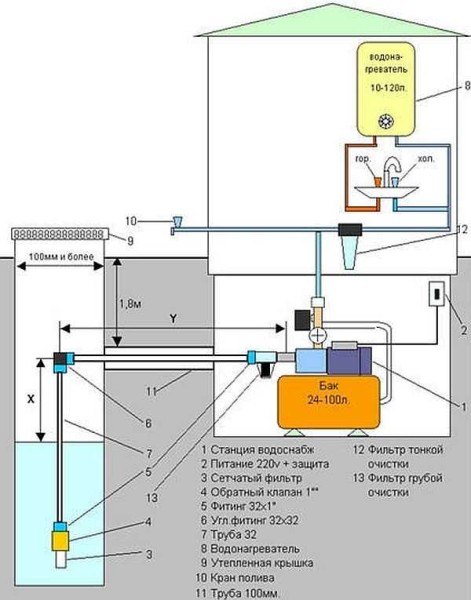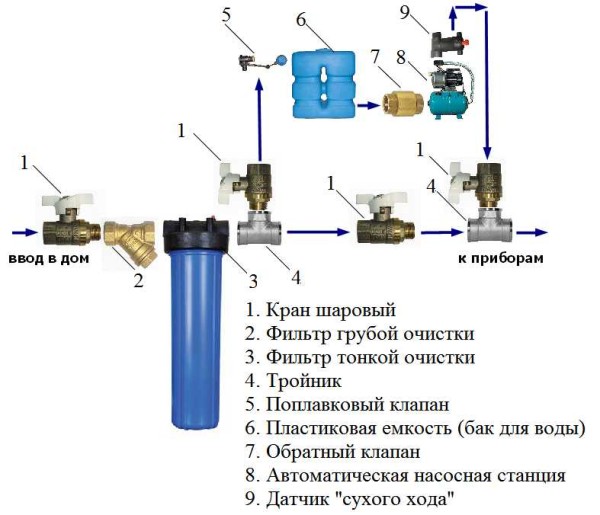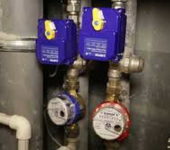How to bring water into a house from a well or well
The water supply of a private house is most often made from a well and a well. Pumps are used for automatic feeding. Their type and performance are selected depending on the water consumption and the height to which it needs to be raised. There are two types of private water supply systems:
- with a storage tank;
- with a hydraulic accumulator.
For uninterrupted water supply of a private house with a stable pressure and water supply, you can supply both a storage tank and a hydraulic accumulator. This is an option for those who value comfort.
The content of the article
Storage tank system
The basis of such a system is a water tank, which is installed at a considerable height. If there is space, the tank is placed in the attic, if not, you can build a special tower or install it on the roof of a nearby structure. Pipes diverge from the container through the house, distributing water to consumption points.
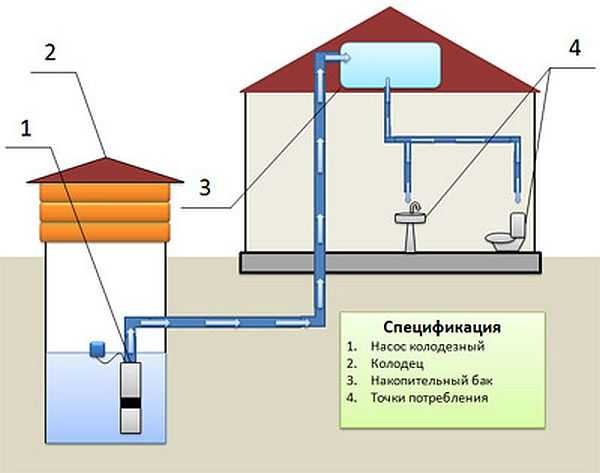
The water supply system of a private house with a storage tank (from a well or a well - it doesn't matter)
This system works like this:
- Water from a well or borehole is pumped into the tank, its level is controlled by a float mechanism. When the threshold is reached, the pump is switched off.
- Due to the fact that the storage tank is located above all the water distribution points, some pressure is created in the system. When the tap is opened, due to this pressure, water enters the dispensing point.
- When the water level in the tank drops below a certain mark, the pump turns on, adding water.
The water supply system of a private house or summer cottage with a storage tank is simple and inexpensive. But there are a number of serious disadvantages:
- With such an organization of water supply, the pressure in the system is low, and even variable - it depends on the water level in the tank and the number of open taps. Because of this, no household appliances will work (automatic washing machine, electric water heater (boiler), dishwasher, autonomous heating system, etc.).
- If the automation fails, there is a real threat to flood the house with overflowing water. The danger can be reduced by making an emergency drainage system. To do this, a pipe is welded into the storage tank just above the required water level, through which, if the level rises, the excess flows out. The pipe can be taken out into the sewer or drainage system, or into the garden. But we need some kind of indication that there is too much water in the tank (the sound of pouring water is also one of the signals).
- The container has a solid size, and it is not always easy to find a place for it. Alternatively, build a tower next to the house, on which to place a water tank.
If no equipment is foreseen at the dacha, you can also use such a water supply scheme. But in the house, very few people will be satisfied with this option. The next option will need to be considered.
Scheme with a hydraulic accumulator and a pumping station
This water supply system of a private house from a well and a well provides a stable pressure, therefore, any equipment can be connected. It is also based on a pump, but it supplies water to a hydraulic accumulator, and is controlled by an automation system. If all these components are combined into one device, it is called a pumping station.
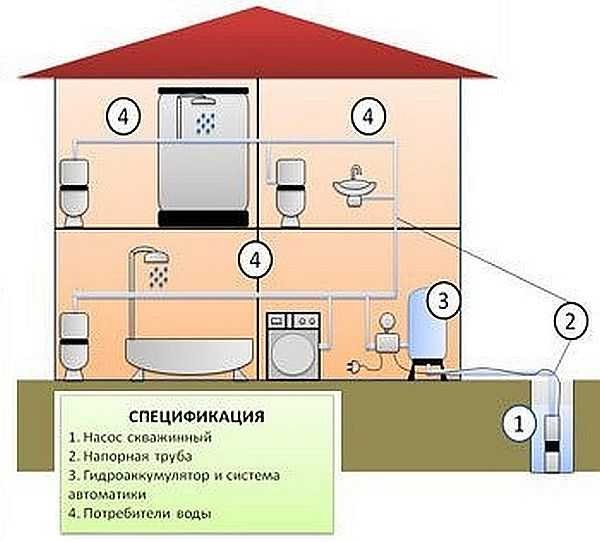
Water supply scheme of a private house with a hydraulic accumulator
The hydraulic accumulator for the water supply is an iron tank divided into two parts by an elastic membrane (rubber).In one part, gas is pumped under a certain pressure, in the second water is supplied. Filling the tank with water, it stretches the membrane, compressing the gas even more, which is why pressure is created in the system.
The principle of operation of a water supply system with a hydraulic accumulator is as follows:
- The pump turns on, pumps water, creating a given pressure in the system. It is controlled by sensors. There are two of them: upper and lower pressure thresholds. When the upper threshold is reached, the sensor turns off the pump.
- When the tap is opened or water is consumed by the technique, a gradual decrease in pressure in the system occurs. When the lower threshold is reached, the second sensor gives a command to turn on the pump. Water is supplied again, leveling it.
Such an autonomous water supply system provides a higher level of comfort. But its organization requires more funds: the pumping station and the hydraulic accumulator are quite expensive devices. In addition, this equipment is more demanding on the quality of water (minimum of impurities) for which a good filter must be installed. There are requirements both for the pipeline (smooth inner walls) and for the pump performance: water must be supplied constantly, without interruptions. When using a well as a source of water, it must have a good debit (water must flow quickly), which is not always possible. Therefore, such schemes are more often implemented with wells.
About how to assemble a borehole pump, see the video.
Water supply of a private house from a well and a well: pipe laying
Any of the described water supply schemes for a private house is implemented using a pump that supplies water to the house. In this case, a pipeline must be built connecting the well or well with a pumping station or storage tank. There are two pipe-laying options - for summer use only or for all-season (winter) use.
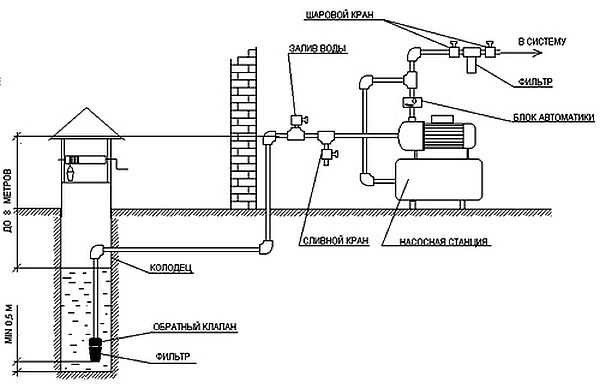
A section of a horizontal pipe can be located either below the depth of soil freezing or it needs to be insulated
When installing a summer water supply system (for summer cottages), pipes can be laid on top or in shallow ditches. At the same time, you must not forget to make a tap at the lowest point - to drain the water before winter, so that in the frost the frozen water does not break the system. Or make a collapsible system - from pipes that can be rolled on threaded fittings - and these are HDPE pipes. Then, in the fall, everything can be disassembled, rolled up and stored. Return everything in the spring.
Laying water pipes around the site for winter use requires a lot of time, effort and money. Even in the most severe frosts, they should not freeze. And there are two solutions:
- lay them below the depth of soil freezing;
- bury it shallowly, but be sure to heat or insulate (or you can do both).
Deep laying
It makes sense to bury the water pipes deeply if it freezes no more than 1.8 m.You will have to dig another 20 cm deeper, and then pour sand on the bottom, into which the pipes in a protective shell will be laid: they will be subjected to a solid load, because from above almost two-meter soil layer. Previously, asbestos pipes were used as a protective shell. Today there is also a plastic hoop sleeve. It is cheaper and lighter, it is easier to lay pipes in it and give it the desired shape.
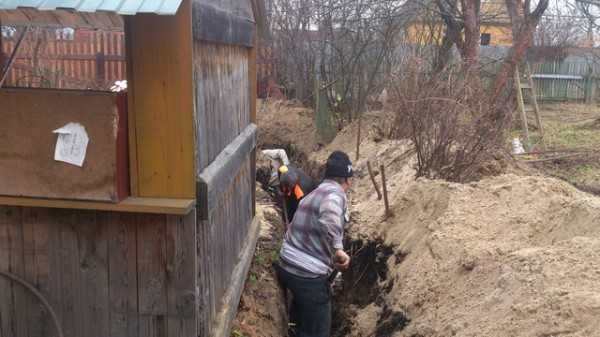
When laying the pipeline below the freezing depth, it is necessary to dig a deep trench long for the entire route. But the water supply of a private house from a well and a well will not freeze in winter
Although this method is labor intensive, it is used because it is reliable. In any case, they try to lay the section of the water supply between the well or the well and the house just below the freezing depth. The pipe is led out through the wall of the well below the depth of freezing of the soil and into the trench is led under the house, where it is raised higher. The most problematic place is the exit from the ground to the house, which can be additionally heated with an electric heating cable.It works in automatic mode, maintaining the preset heating temperature - it works only if the temperature is lower than the preset one.
When using a well and a pumping station as a water source, a caisson is installed. It is buried below the depth of freezing of the soil, equipment is placed in it - a pumping station. The casing pipe is cut so that it is above the bottom of the caisson, and the pipeline is taken out through the caisson wall, also below the freezing depth.
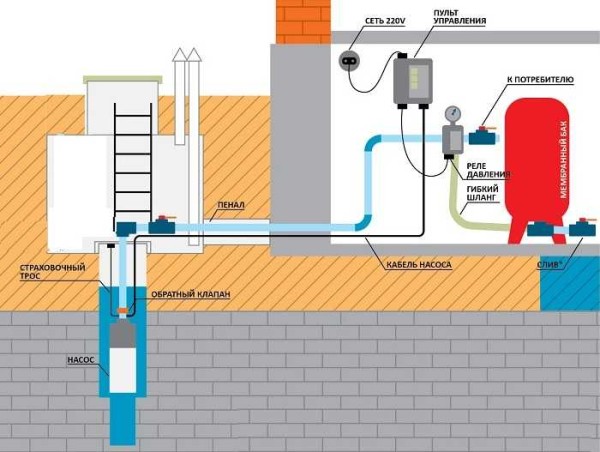
Laying water pipes in a private house from a well when installing a caisson
A water pipe buried in the ground is difficult to repair: it will have to be dug in. Therefore, try to lay a solid pipe without joints and welds: they are the ones that give the most problems.
Close to the surface
With shallow earthworks, there is less excavation, but in this case it makes sense to make a full-fledged route: lay out the trench with bricks, thin concrete slabs, etc. At the construction stage, the costs are significant, but the operation is convenient, repair and modernization are no problem.
In this case, the water supply pipes of a private house from the well and the well rise to the level of the trench and are removed there. They are packed in thermal insulation that prevents them from freezing. You can also warm them up for insurance - use heating cables.
One practical tip: if a power cable goes from a submersible or borehole pump to the house, it can be hidden in a protective sheath made of PVC or other material, and then attached to the pipe. Fasten every meter with a piece of tape. So you will be sure that the electrical part is safe, the cable will not fray or break: when the ground moves, the load will be on the pipe, and not on the cable.
Sealing the entrance to the well
When organizing the water supply of a private house from a well with your own hands, pay attention to the sealing of the place where the water pipe exits the mine. It is from here that the dirty top water most often gets inside.
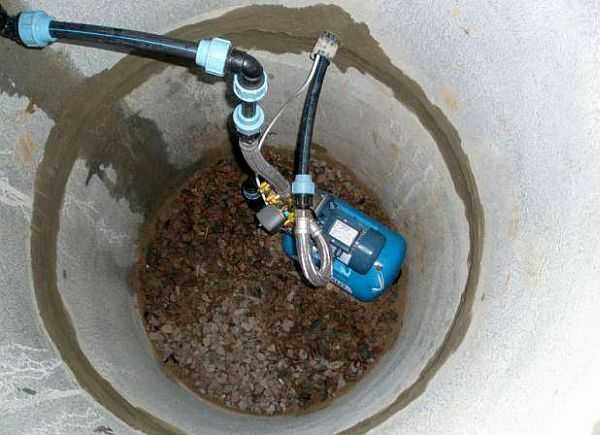
It is important to seal the outlet of the water pipe from the well shaft well
If the hole in the shaft wall is not much larger than the pipe diameter, the gap can be sealed with sealant. If the gap is large, it is covered with a solution, and after drying, it is coated with a waterproofing compound (bituminous impregnation, for example, or a cement-based composition). It is desirable to smear both outside and inside.
What does it consist of
The source of water and its input into the house is far from the entire water supply system. We need more filters. The first, coarse filtration occurs even at the suction point. In this form, it can be used for technical purposes, for example, to bring it to the toilet. But even for irrigation, untreated water can not be served in every case, but even more so in the shower or in the kitchen. Therefore, the water supply of a private house from a well and a well also includes a filter system.
Please note: there are three filtration stages in the figure:
- on the suction pipe - a strainer;
- before entering the pump - a coarse filter;
- before entering the house - a fine filter.
At each stage, the filter (or filters) is selected depending on the water. Its quality is determined in the laboratory. Cleaning equipment is selected based on the chemical composition.
Autonomous water supply
Systems with pumping stations are good for everyone, except for the fact that they require electricity to work. There is a supply of water, but it is equal to the volume of the accumulator, and it is not more than 100 liters. This amount will not last long. If you need a reserve stock for at least a day or more, it is best to pump water first into the storage tank, and from it feed it to the input of the pumping station. The same system works well if your house is connected to a centralized water supply, but the pressure is very low or the water is supplied on an hourly basis.
In the diagram shown in the photo, there is only an emergency overflow. This is the piping leaving the storage tank just above the maximum water level. It is discharged into the sewer. Excess water flows down it in case of malfunctions with the float mechanism. If you don't install it, you can flood the house.
If you need a backup water supply of a private house in case of a power outage, the drive must be installed at the top, above all the water points. Then, when the electrics are turned off, water will be fed into the pipes by gravity. You cannot take a shower, but it will be in the taps. It will provide uninterrupted water supply to a private house in any conditions.

